comm.Ray
Create RF propagation ray
Description
A comm.Ray object contains the properties of an RF
propagation ray. The object contains the geometric and electromagnetic information of a radio
wave (approximated as a ray) that propagates from one point to another point.
Creation
Typically you create comm.Ray objects by using the raytrace function.
Description
ray = comm.Ray
ray = comm.Ray(Name=Value)comm.Ray(CoordinateSystem="geographic",TransmitterLocation=[40.730610;-73.935242;0])
creates a ray referenced to a geographic coordinate system with a transmitter located in
New York City.
Properties
Propagation path specification method, specified as one of these values.
'Locations'— The ray object path between waypoints are conveyed as (x, y, z) coordinate points by theTransmitterLocation,ReceiverLocation, and, if applicable,Interactionsproperties.'Delay and angles'— The ray object path between waypoints are conveyed by thePropagationDelay,AngleOfDeparture, andAngleOfArrivalproperties.
Data Types: char | string
Coordinate system, specified as 'Cartesian' or
'Geographic'. When you set the
CoordinateSystem property to 'Geographic', the
coordinate system is defined relative to the WGS-84 Earth ellipsoid model and the object
defines angles relative to the local East-North-Up (ENU) coordinate system at the
transmitter and receiver.
Dependencies
To enable this property, the PathSpecification property must
be 'Locations'.
Data Types: char | string
Cartesian coordinate system scale, in meters, specified as a positive scalar.
Dependencies
To enable this property, the PathSpecification property must
be 'Locations' and the CoordinateSystem
property must be 'Cartesian'.
Data Types: double
Transmitter location, specified as a three-element numeric column vector of coordinates in one of these forms.
[x; y; z] — This form applies when you set the
CoordinateSystemproperty to'Cartesian'. The object does not perform range validation for x, y, and z.[latitude; longitude; height] — This form applies when you set the
CoordinateSystemproperty to'Geographic'. latitude must be in the range [–90, 90]. The object does not perform range validation for longitude and height. height is referenced to the ellipsoid defined by the World Geodetic System of 1984 (WGS84).
Dependencies
To enable this property, the PathSpecification property must
be 'Locations'.
Data Types: double
Receiver location, specified as a three-element numeric column vector of coordinates in one of these forms.
[x; y; z] — This form applies when you set the
CoordinateSystemproperty to'Cartesian'. The object does not perform range validation for x, y, and z.[latitude; longitude; height] — This form applies when you set the
CoordinateSystemproperty to'Geographic'. latitude must be in the range [–90, 90]. The object does not perform range validation for longitude and height. height is referenced to the ellipsoid defined by the World Geodetic System of 1984 (WGS84).
Dependencies
To enable this property, the PathSpecification property must
be 'Locations'.
Data Types: double
Line-of-sight indicator, specified as logical 1
(true) or 0 (false).
A value of
1(true) means that the ray has an unobstructed path from the transmitter to the receiver.A value of
0(false) means that path from the transmitter to the receiver is obstructed.
Dependencies
To enable this property, the PathSpecification property must
be 'Locations'.
Data Types: logical
Ray-interface interactions along the propagation path, specified as a 1-by-NI structure containing these fields. NI is the number of interactions.
Type of ray-interface interaction, specified as
'Reflection' or 'Diffraction'.
Data Types: char | string
Location of the ray-interface interaction, specified as a 3-by-1 numeric vector containing the coordinates of one interaction point on the ray.
When the
CoordinateSystemproperty is set to'Cartesian', the form is [x; y; z]. The object does not perform range validation for x, y, and z.When the
CoordinateSystemproperty is set to'Geographic', the form is [latitude; longitude; height]. The latitude must be in the range [–90, 90]. The object does not perform range validation for longitude and height. height is referenced to the ellipsoid defined by the World Geodetic System of 1984 (WGS84).
Data Types: double
Name of the material associated with the ray-interface interaction, specified as a string scalar.
Data Types: char | string
Dependencies
To enable this property, the PathSpecification property must
be 'Locations' and the LineOfSight property
must be 0 (false).
Data Types: struct
Propagation delay in seconds, specified as a nonnegative scalar. The default value
is computed using the default values of the TransmitterLocation and
ReceiverLocation properties for a line-of-sight ray.
When you set the
PathSpecificationproperty to'Locations', this property is read-only and the value is derived fromTransmitterLocation,ReceiverLocationand, if applicable, theInteractions.When you set the
PathSpecificationproperty to'Delay and angles', this property is configurable.
Data Types: double
This property is read-only.
Propagation distance in meters, specified as a nonnegative scalar. The default value
is computed using the default values of the TransmitterLocation and
ReceiverLocation properties for a line-of-sight ray.
When you set the
PathSpecificationproperty to'Locations', the value is derived fromTransmitterLocation,ReceiverLocationand, if applicable, theInteractions.When you set the
PathSpecificationproperty to'Delay and angles', the value is derived fromPropagationDelay.
Data Types: double
Angle of departure, in degrees, of the ray departing the transmitter, specified as a
numeric vector of the form [az; el]. The azimuth
angle, az, is measured from the positive x-axis
counterclockwise around the z-axis and must be in the range (–180,
180]. The elevation angle, el, is measured from the
xy-plane and must be in the range [–90, 90]. The default value is
computed using the default values of the TransmitterLocation and
ReceiverLocation properties for a line-of-sight ray.
When you set the
PathSpecificationproperty to'Delay and angles', this property is configurable.When you set the
PathSpecificationproperty to'Locations', this property is read-only and the value is derived fromTransmitterLocation,ReceiverLocationand, if applicable, theInteractions.When
CoordinateSystemis set to'Geographic', the angles are defined with reference to the local East-North-Up (ENU) coordinate system at transmitter.
Data Types: double
Angle of arrival, in degrees, of the ray arriving at the receiver, specified as a
numeric vector of the form [az; el]. The azimuth
angle, az, is measured from the positive x-axis
counterclockwise around the z-axis and must be in the range (–180,
180]. The elevation angle, el, is measured from the
xy-plane and must be in the range [–90, 90]. The default value is
computed using the default values of the TransmitterLocation and
ReceiverLocation properties for a line-of-sight ray.
When you set the
PathSpecificationproperty to'Delay and angles', this property is configurable.When you set the
PathSpecificationproperty to'Locations', this property is read-only and the value is derived fromTransmitterLocation,ReceiverLocationand, if applicable, theInteractions.When
CoordinateSystemis set to'Geographic', the angles are defined with reference to the local East-North-Up (ENU) coordinate system at receiver.
Data Types: double
This property is read-only.
Number of ray-interface interactions for the ray object from the transmitter to the
receiver, specified as a nonnegative integer. The value is derived from
LineOfSight and, if applicable,
Interactions.
Dependencies
To enable this property, the PathSpecification property must
be 'Locations'.
Data Types: double
Signal frequency in Hz, specified as a positive scalar.
Data Types: double
Path loss source, specified as 'Free space model' or
'Custom'.
Data Types: char | string
Path loss in dB, specified as a nonnegative scalar. The default value is computed
using the default values of the TransmitterLocation and
ReceiverLocation properties for a line-of-sight ray.
When you set the
PathLossSourceproperty to'Free space model', thePathLossproperty is read-only and derived from thePropagationDistanceandFrequencyproperties by using the free space propagation model.When you set the
PathLossSourceproperty to'Custom', you can set thePathLossproperty, independent of the geometric properties.
Data Types: double
Phase shift in radians, specified as a numeric scalar. The default value is computed
using the default values of the TransmitterLocation and
ReceiverLocation properties for a line-of-sight ray.
When you set the
PathLossSourceproperty to'Free space model', thePhaseShiftproperty is read-only and derived from thePropagationDistanceandFrequencyproperties by using the free space propagation model.When you set the
PathLossSourceproperty to'Custom', you can set thePhaseShiftproperty, independent of the geometric properties.
Data Types: double
Object Functions
plot (rays) | Display RF propagation rays in Site Viewer |
Examples
Perform ray tracing in Hong Kong and return the rays in comm.Ray objects. The comm.Ray objects contain geometric and electromagnetic information for propagation paths between the transmitter and receiver sites.
Launch Site Viewer with buildings in Hong Kong. For more information about the OpenStreetMap® file, see [1].
viewer = siteviewer(Buildings="hongkong.osm");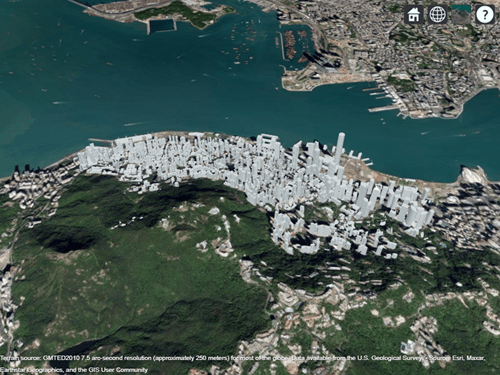
Create transmitter and receiver sites.
tx = txsite(Latitude=22.2789,Longitude=114.1625, ... AntennaHeight=10,TransmitterPower=5, ... TransmitterFrequency=28e9); rx = rxsite(Latitude=22.2799,Longitude=114.1617, ... AntennaHeight=1);
Create a ray tracing propagation model, which MATLAB® represents using a RayTracing object. Configure the model to find paths with up to 3 surface reflections and up to 1 edge diffraction. By default, the model uses the shooting and bouncing rays (SBR) method.
pm = propagationModel("raytracing",MaxNumReflections=3,MaxNumDiffractions=1);Perform the ray tracing analysis. The raytrace function returns a cell array containing the comm.Ray objects. By default, ray tracing models discard rays that are more than 40 decibels weaker than the strongest path.
rays = raytrace(tx,rx,pm)
rays = 1×1 cell array
{1×15 comm.Ray}
Display the properties of the first comm.Ray object. The value of the LineOfSight property is 1, and value of the NumInteractions property is 0. This combination indicates that the ray defines a line-of-sight path.
rays{1}(1)ans =
Ray with properties:
PathSpecification: 'Locations'
CoordinateSystem: 'Geographic'
TransmitterLocation: [3×1 double]
ReceiverLocation: [3×1 double]
LineOfSight: 1
Frequency: 2.8000e+10
PathLossSource: 'Custom'
PathLoss: 104.2656
PhaseShift: 4.6406
Read-only properties:
PropagationDelay: 4.6442e-07
PropagationDistance: 139.2294
AngleOfDeparture: [2×1 double]
AngleOfArrival: [2×1 double]
NumInteractions: 0
Display the properties of the third comm.Ray object. The value of the LineOfSight property is 0, and the value of the NumInteractions property is 2. This combination indicates that the ray defines a path with two interface interactions.
rays{1}(3)ans =
Ray with properties:
PathSpecification: 'Locations'
CoordinateSystem: 'Geographic'
TransmitterLocation: [3×1 double]
ReceiverLocation: [3×1 double]
LineOfSight: 0
Interactions: [1×2 struct]
Frequency: 2.8000e+10
PathLossSource: 'Custom'
PathLoss: 142.4192
PhaseShift: 0.7186
Read-only properties:
PropagationDelay: 8.3065e-07
PropagationDistance: 249.0217
AngleOfDeparture: [2×1 double]
AngleOfArrival: [2×1 double]
NumInteractions: 2
Display the interaction types, locations, and materials by querying the Interactions property.
rays{1}(3).Interactions(1)ans = struct with fields:
Type: 'Diffraction'
Location: [3×1 double]
MaterialName: "concrete"
rays{1}(3).Interactions(2)ans = struct with fields:
Type: 'Reflection'
Location: [3×1 double]
MaterialName: "concrete"
Visualize the sites and the ray tracing paths.
show(tx)
show(rx)
plot(rays{1})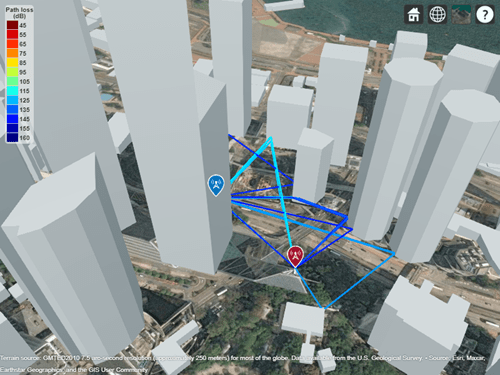
Appendix
[1] The OpenStreetMap file is downloaded from https://www.openstreetmap.org, which provides access to crowd-sourced map data all over the world. The data is licensed under the Open Data Commons Open Database License (ODbL), https://opendatacommons.org/licenses/odbl/.
Perform ray tracing in Chicago and return the rays in comm.Ray objects. Then, display the rays without performing the ray tracing analysis again.
Launch Site Viewer with buildings in Chicago. For more information about the OpenStreetMap® file, see [1].
viewer = siteviewer(Buildings="chicago.osm");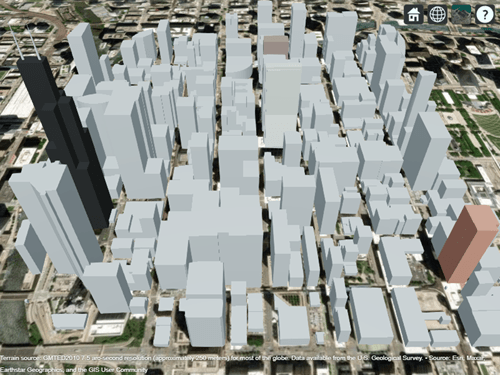
Create a transmitter site on one building and a receiver site on another building. Show the line-of-sight path between the sites using the los function.
tx = txsite(Latitude=41.8800, ... Longitude=-87.6295, ... TransmitterFrequency=2.5e9); rx = rxsite(Latitude=41.881352, ... Longitude=-87.629771, ... AntennaHeight=30); los(tx,rx)
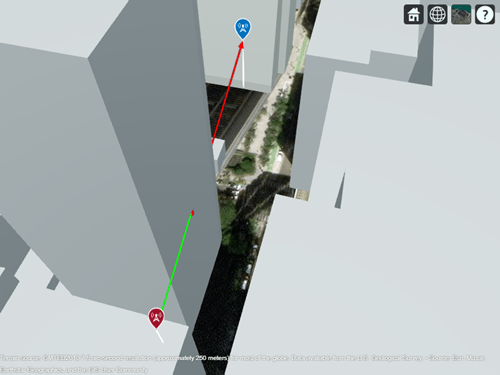
Create a ray tracing propagation model, which MATLAB® represents using a RayTracing object. By default, the model uses the SBR method and calculates propagation paths with up to two reflections.
pm = propagationModel("raytracing");Perform the ray tracing analysis. The raytrace function returns a cell array containing the comm.Ray objects.
rays = raytrace(tx,rx,pm)
rays = 1×1 cell array
{1×3 comm.Ray}
View the properties of the first ray object.
rays{1}(1)ans =
Ray with properties:
PathSpecification: 'Locations'
CoordinateSystem: 'Geographic'
TransmitterLocation: [3×1 double]
ReceiverLocation: [3×1 double]
LineOfSight: 0
Interactions: [1×1 struct]
Frequency: 2.5000e+09
PathLossSource: 'Custom'
PathLoss: 92.7686
PhaseShift: 1.2945
Read-only properties:
PropagationDelay: 5.7088e-07
PropagationDistance: 171.1462
AngleOfDeparture: [2×1 double]
AngleOfArrival: [2×1 double]
NumInteractions: 1
Close Site Viewer.
close(viewer)
Create another Site Viewer with the same buildings, transmitter site, and receiver site. Then, display the propagation paths. Alternatively, you can plot individual paths by specifying a single ray object, for example rays{1}(2).
siteviewer(Buildings="chicago.osm"); show(tx) show(rx) plot(rays{1},Type="power", ... TransmitterSite=tx,ReceiverSite=rx)
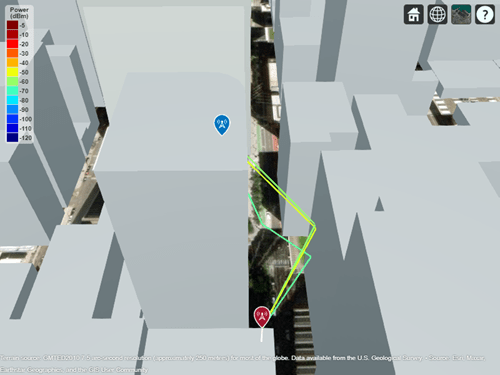
Appendix
[1] The OpenStreetMap file is downloaded from https://www.openstreetmap.org, which provides access to crowd-sourced map data all over the world. The data is licensed under the Open Data Commons Open Database License (ODbL), https://opendatacommons.org/licenses/odbl/.
Extended Capabilities
C/C++ Code Generation
Generate C and C++ code using MATLAB® Coder™.
Version History
Introduced in R2020aThe ReflectionLocations and NumReflections
properties have been removed. To accommodate reflections, use the Interactions property to
replace the ReflectionLocations property and use the NumInteractions property
to replace the NumReflections property.
See Also
Functions
Objects
MATLAB Command
You clicked a link that corresponds to this MATLAB command:
Run the command by entering it in the MATLAB Command Window. Web browsers do not support MATLAB commands.
选择网站
选择网站以获取翻译的可用内容,以及查看当地活动和优惠。根据您的位置,我们建议您选择:。
您也可以从以下列表中选择网站:
如何获得最佳网站性能
选择中国网站(中文或英文)以获得最佳网站性能。其他 MathWorks 国家/地区网站并未针对您所在位置的访问进行优化。
美洲
- América Latina (Español)
- Canada (English)
- United States (English)
欧洲
- Belgium (English)
- Denmark (English)
- Deutschland (Deutsch)
- España (Español)
- Finland (English)
- France (Français)
- Ireland (English)
- Italia (Italiano)
- Luxembourg (English)
- Netherlands (English)
- Norway (English)
- Österreich (Deutsch)
- Portugal (English)
- Sweden (English)
- Switzerland
- United Kingdom (English)